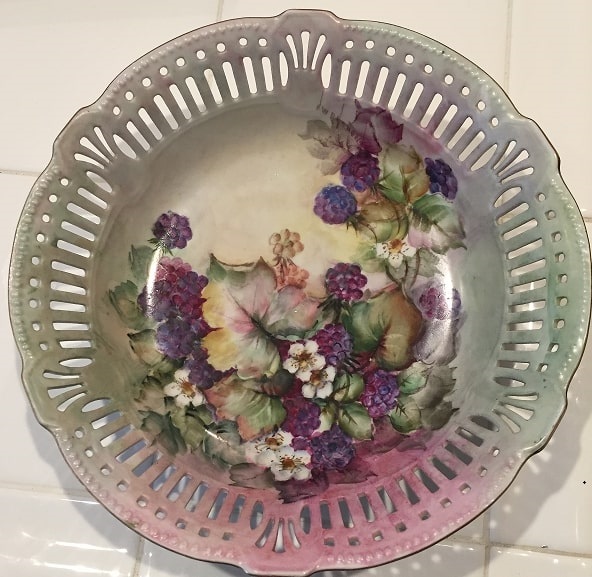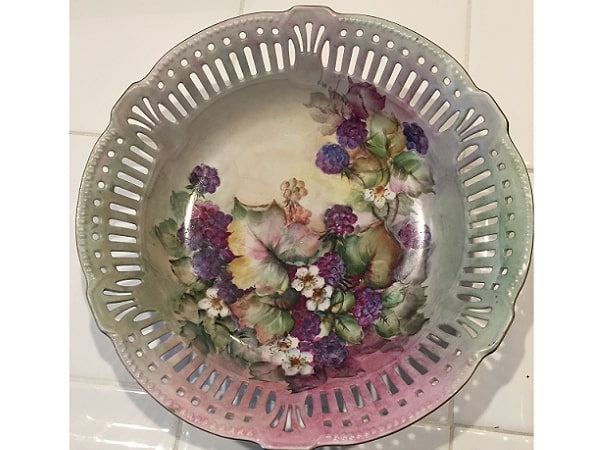Introduction: In this article – in honor of Mother’s Day – Gena Philibert-Ortega writes about documenting and caring for family heirlooms inherited from your mother. Gena is a genealogist and author of the book “From the Family Kitchen.”
Genealogy is much more than searching for paper documents that list facts about our ancestors’ lives. In addition to the documents we search for and gather, once you are known as the family historian, you may inherit various family heirlooms or “stuff” as well.
Your home archive might include items inherited from female ancestors, from your own mom back multiple generations. This stuff can span the everyday to things she was gifted or used on special occasions. Items may hold special memories of how or when they were used, or might just serve as a reminder of a story of her life.
I was given my great-grandmother’s hand-painted china bowl.

What’s special about that piece is that it includes information about her 50th wedding anniversary.

What have you inherited from your mom? Your home may include the following items (or more):
- Clothing
- Jewelry
- China
- Silver
- Linens
- Quilts
- Cookbooks
- Recipe cards
- Aprons
- Kitchen tools
- Furniture
- Books
- Correspondence
- Diaries/Birthday books/Scrapbooks
- Photographs
- Collectibles
If you’re like me, you may own items that are typical heirlooms (such as jewelry and china) combined with other items that are unique (I have a bar of soap my maternal grandmother made, and my paternal grandmother’s 5th grade math book). What are you doing to make sure the stories of those items get documented, and to ensure the future of the items?
Provenance
I think one of the things we as genealogists probably don’t concentrate on enough is preserving and documenting heirlooms. You can find information online for how to safely store the items, which is important, but you also need to document the items for future generations.
Documentation is imperative so that future generations know what the item is, whose it was, and its importance. One of my sons recently said “I don’t know what is important and what isn’t” when discussing my collection of family history. He’s right. And he needs to know that now while I’m alive so that he can make decisions about these items in the future.
You could create your own documentation form depending on the item, and include answers to questions such as:
- Date
- What is this item? (Description)
- Where is it currently stored?
- What is it made from?
- When was it made?
- Who originally owned it?
- How is it used? Does it have instructions?
- If it is handmade, who made it?
- What significance does it have for our family?
- What stories are there about this item?
- Why should it be kept in the family?
- Who should be contacted about keeping this item?
- How should this item be cared for or stored?
Don’t forget to also add photographs so that the item is easily recognized. Obviously, depending on the type of item, there might be more detail added. In the case of a quilt or textile, you may provide the size and more details about its construction. Your family won’t know the familial value of an heirloom (or maybe what an heirloom is versus other antiques you collect) if you don’t provide this information.
Take Care of the Future
So now that your item is documented, how do you preserve it for the future? Well, it depends on what it is, but in general your heirlooms like what we like: no direct sunlight, no bugs, a comfortable temperature, and stored in the home but not in the attic or garage. Each item will have its own challenges in terms of preservation and storage. Items made of paper can deteriorate because of the acids in the paper. How you preserve those items is going to be different than an item made of metal.
There are various places online to learn more about preserving the items that genealogists inherit. The Library of Congress Collections Care web page is a good place to begin. Genealogists Melissa Barker and Denise Levenick both have great posts on preserving various family heirlooms on their respective websites A Genealogist in the Archives and The Family Curator. You can also consult online sources for books that focus on the care and storage of particular types of heirlooms or collectibles.
Preserve All Parts of Her Life
Genealogy is much more than facts printed on paper. It’s the images we collect, the heirlooms we inherit, and the material items that remind us of family. Documenting and preserving those items are a part of our family history work.
Happy Mother’s Day!
